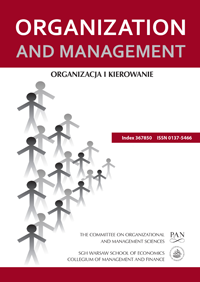Determinants and conditions of the personnel function which shape a sense of professional satisfaction - a comparative analysis
Main Article Content
Abstract
This article describes the comparative analysis of employee satisfaction level in the context of selected HRM determinants in various types of organizations and industries. The assumption was made that the objective attributes of the sense of professional satisfaction (in the form of variables shaping the nominal quality of the personnel function) influence the perception of the subjective feeling of job satisfaction. On that basis, the following research problems were posed – does the potential high quality of the personnel function translate into a high sense of employee satisfaction? Therefore, the main cognitive objective of the adopted research was an attempt to identify the occurrence of the potential impact of selected determinants of the quality of the personnel function on the results and distributions of the obtained indicators of job satisfaction. The basic conclusion from the research is the statement that the high quality level of the modern personnel function determines the increase of the sense of professional satisfaction, however the sources of this satisfaction (subjective attributes) are quite diverse and do not depend directly on the impact of HRM quality in the organization.
Article Details
References
Borowska-Pietrzak A. [2014], Measurement of the sense of professional satisfaction. The results of pilot studies, in: Success in HR management. Diversity in human capital management – approaches, methods, tools, vol. 2, M. Stor, A. Fornalczyk (eds.), Management
and psychological problems, University of Economics Publishing House in Wroclaw.
Dyduch W., Bratnicka K. [2014], A re-look at the social capital of the organization, Organization and Management 1A.
Holbeche L. [2003], Understanding Change, Butterworth-Heinemann, Oxford.
Juchnowicz M. [2012], Employees’ commitment. Ways of assessment and motivation, PWE, Warszawa.
Kawka T. [2014], Remuneration in the organizations of the new economy. Conditions. Functions. Configuration, University of Economics Publishing House in Wroclaw, Wrocław.
Kunasz M. [2007], Personnel function measurement system in a company – a set of individually selected measures and indicators, in: J. Poteralski (ed.), Changes of the labour market in the context of social and economic processes, Department of Microeconomics,
University of Szczecin, Szczecin.
Lawler E.E. [1996], From the Ground up. Six Principles for Building the New Logic Corporation, Jossey-Bass, San Francisco.
[9] Listwan T. [2008], Contemporary tendencies in the management of the organization’s
personnel, in: T. Borys, P. Rogala (eds.), Personnel management as a criterion of excellence,
PN University of Economics in Wroclaw no. 31, University of Economics Publishing
House in Wroclaw.
Listwan T. [2010], Human resources management, CH Beck, Warsaw.
Nowak M. [2014], Personnel controlling in the company, House Wolters Kluwert.
Snell S., Bohlander G. [2004], Managing Human Resources, Thomson South-Western, New York.
Strużyna J. [2005], Outside the norm of human resources management, Publishing House of the Higher Banking School in Dąbrowa Górnicza, Dąbrowa Górnicza.
Waal de. A., Coevert V. [2007], The effect of performance management on organizational results of a bank, The International Journal of Productivity and Performance Management 56 (5–6), Emerald Publishing, Bingley
